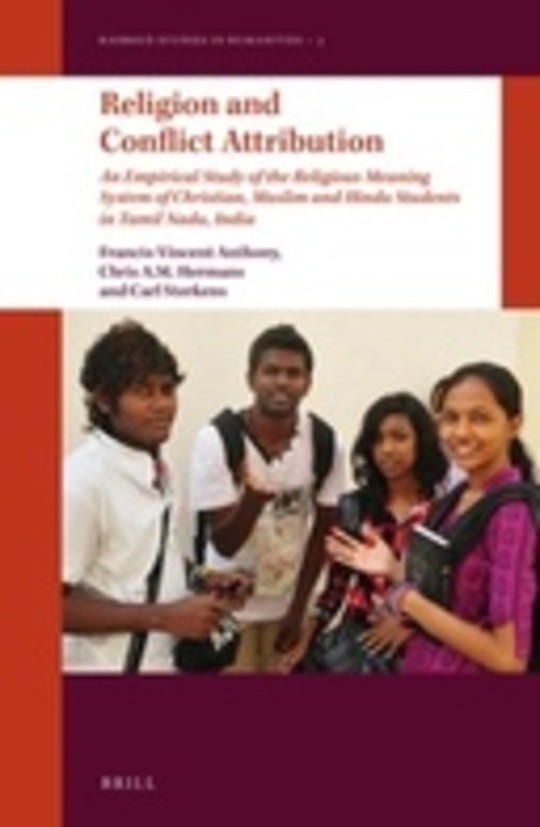
Religion and Conflict Attribution
Free
Description
Contents
Reviews
Language
English
ISBN
Unknown
Contents
List of Figures and Tables
Introduction
1. Comparative Research into Conflict in Tamil Nadu
Introduction
1.1 Focus and Scope of the Research
1.2 Religious and Cultural Context of the Research
1.2.1 Tamil Culture and Hindu Religion
1.2.2 Christianity in the Tamil Cultural Context
1.2.3 Islam in the Tamil Cultural Context
1.2.4 Religion and Culture in the Struggle to Define Indian Identity and Heritage
1.2.5 Nationalism, Fundamentalism and Religiously Motivated Conflict
1.3 Research Problem: Religion and Conflict
1.3.1 Causes of Interreligious Conflict
1.3.2 Predictors of Perceived Causes of Interreligious Conflict
1.4 Research Questions
1.5 Research Variables
1.5.1 Causes of Religious Conflicts
1.5.2 Religious Meaning System
1.5.3 Socio-cultural Characteristics
1.5.4 Socio-economic Characteristics
1.5.5 Socio-religious Characteristics
1.6 Sampling and Data Collection
1.7 Design of Analysis
2. Cross-religious Comparative Research
Introduction
2.1 Comparison as a Contested Field in Research into Religion
2.2 Goals of Cross-religious Comparison
2.3 Object of Cross-religious Comparison
2.4 Insider and Outsider Perspective
2.5 Selection of Data in Comparative Research
2.5.1 Knowledge Aims in Cross-religious Comparative Research
2.5.2 Looking for Differences or Similarities?
2.5.3 Sampling
2.6 Levels of Equivalence in Cross-religious Empirical Research
2.7 Normativeness in Comparative Research
3. Religiosity
3.1 Introduction
3.2 Theoretical Framework: Multidimensional Approach to Religiosity
3.3 Empirical Research
3.3.1 Research Questions
3.3.2 Measuring Instrument
3.3.3 Results of Empirical Analysis
3.4 Findings and Discussion
3.4.1 Significance of a Comparative Model of Institutional Religious Practice
3.4.2 Impact of Agents of Religious Socialization and Gender
4. Mystical Experience
4.1 Introduction
4.2 Theoretical Framework
4.3 Empirical Research
4.3.1 Research Questions
4.3.2 Measuring Instrument
4.3.3 Results of Empirical Analysis
4.4 Findings and Discussion
4.4.1 Significance of a Comparative Model of Vertical Mysticism
4.4.2 Personal Characteristics and Vertical Mysticism
5. Interpreting Religious Plurality
5.1 Introduction
5.2 Theoretical Framework: Models of Interpreting Religious Plurality
5.2.1 Replacement
5.2.2 Fulfilment
5.2.3 Mutuality
5.2.4 Acceptance
5.2.5 Relativistic Pluralism
5.3 Empirical Research
5.3.1 Research Questions
5.3.2 Measuring Instruments
5.3.3 Empirical Results
Monism
Commonality Pluralism
Differential Pluralism
5.4 Findings and Discussion
5.4.1 Three Comparative Models of Interpreting Religious Plurality
5.4.2 Cross-religious Differences in Models of Interpreting Religious Plurality
5.4.3 Social Location and Prediction of Models of Interpreting Religious Plurality
6. Religiocentrism
6.1 Introduction
6.2 Theoretical Framework: Religiocentrism and Social Identity Theory
6.3 Empirical Research
6.3.1 Research Questions
6.3.2 Measuring Instruments
6.3.3 Empirical Results
Positive In-group Attitudes
Negative Out-group Attitudes
Positive In-group Attitudes
Negative Out-group Attitudes
Positive In-group Attitudes
Negative Out-group Attitudes
6.4 Findings and Discussion
6.4.1 Findings
Significance of a Comparative Model of Religiocentrism
Social Location and Prediction of Religiocentrism
Discussion
7. Causes of Interreligious Conflict
7.1 Introduction
7.2 Theoretical Framework: Realistic Conflict Group Theory Versus Social Identity Theory
7.2.1 Socio-economic Causes of Interreligious Conflict
7.2.2 Political Causes of Interreligious Conflict
7.2.3 Ethnic-cultural Causes of Interreligious Conflict
7.2.4 Religious Causes of Conflict Between Religious Groups
7.3 Empirical research
7.3.1 Research questions
7.3.2 Measuring Instrument
7.3.3 Empirical Results
7.4 Findings and Discussion
7.4.1 Findings
7.4.2 Discussion
Towards a Theory of Force-Driven and Strength-Driven Interreligious Conflict
Evaluation of Force-Driven Religious Conflict
8. Predictors of Force-driven Religious Conflict
8.1 Introduction
8.2 A meaning system approach to the relation between religion and conflict
8.2.1 Reasons for Choosing a Meaning System Approach
8.2.2 Religious Identity: A Meaning System Approach
8.2.3 Religious Meaning Systems and Religious Conflict: A Dual Relation
8.2.4 Consonance and Dissonance in the Religious Meaning System
8.3 Empirical Research
8.3.1 Research Question
8.3.2 Measuring Instruments
8.3.3 Conceptual Model and Design of Data Analysis
8.3.4 Empirical Results
8.4 Findings and Discussion
8.4.1 Findings
8.4.2 Discussion
Monism
Commonality Pluralism
Religiocentrism: Positive In-group Attitudes
Religiocentrism: Negative Out-group Attitudes
Mother’s Educational Level
9. Conclusion: Prospects for Theory and Practice
9.1 Introduction
9.2 Theory on Religion and Conflict
9.2.1 Attribution of interreligious conflict
Realistic and Identity-Driven Causes of Interreligious Conflict
Force-driven and Strength-driven Religious Conflict
9.2.2 Religious Meaning System
9.3 Practice: The Contribution of Education
9.3.1 Foster Critical Thinking
9.3.2 A Concept of Citizenship
9.3.3 Aspects of Civic Education
9.3.4 Role of Educators
Appendices
Appendix A: Colleges participating in the research: location, religious affiliation, sex, and respondents participation
Appendix B: Questionnaire on agents of religious socialization
Appendix C: Questionnaire on dimensions of religiosity
Appendix D: Questionnaire Mysticiscm
Appendix E: Questionnaire Models of interpreting religious plurality
Appendix F: Questionnaire Religiocentrism
Christian respondents
Muslim respondents
Hindu respondents
Appendix G: Questionnaire: Causes of religious conflict
Bibliography
Index
The book hasn't received reviews yet.




